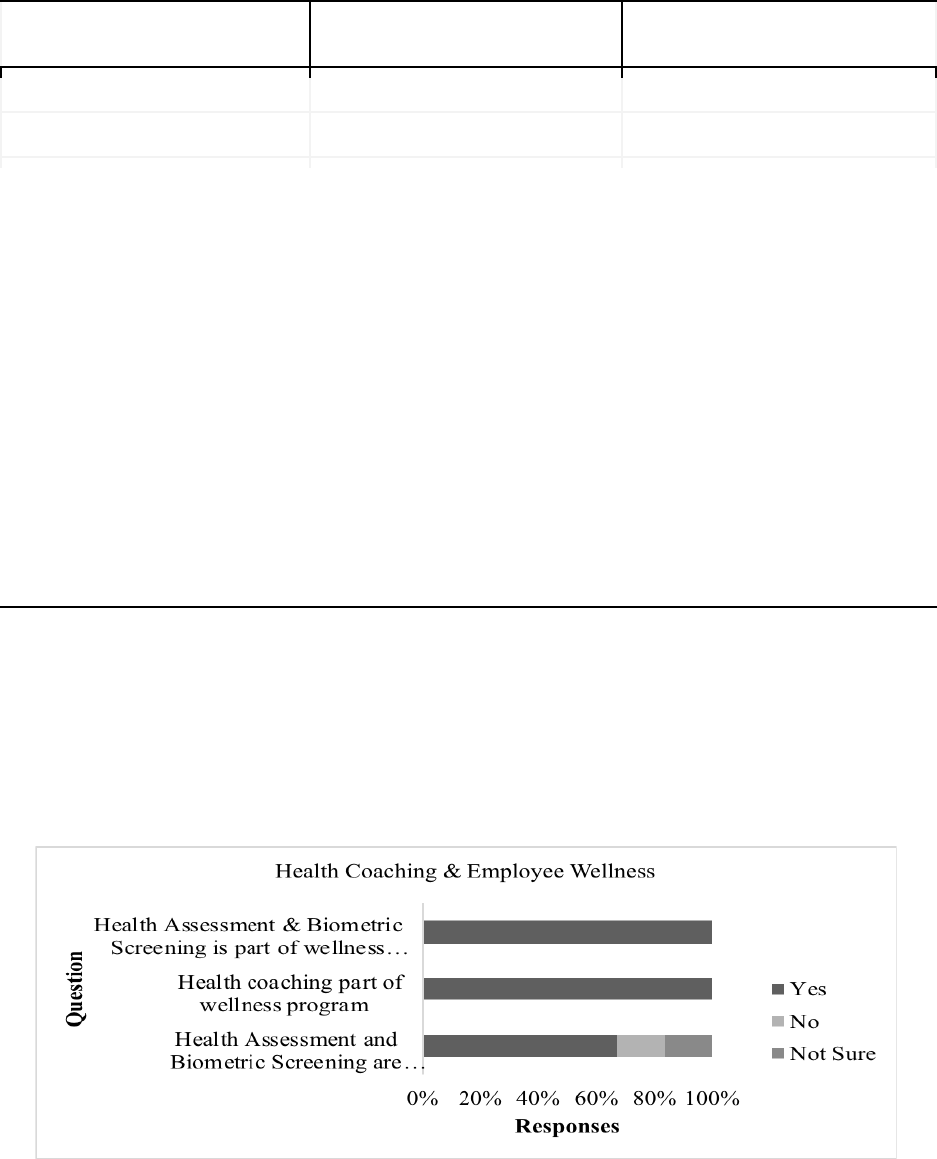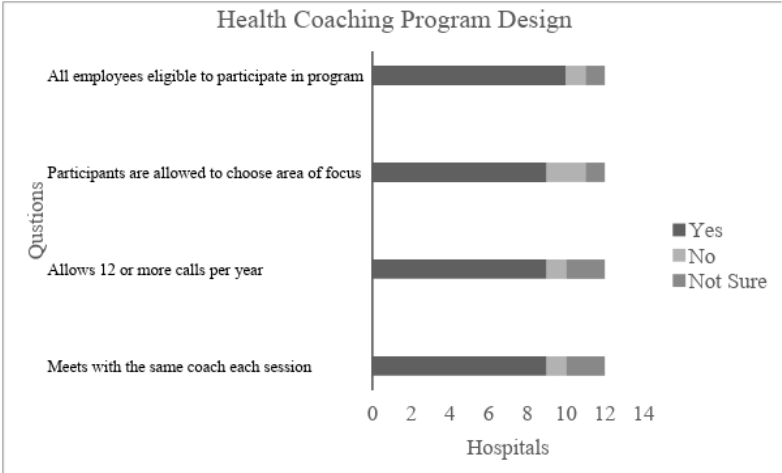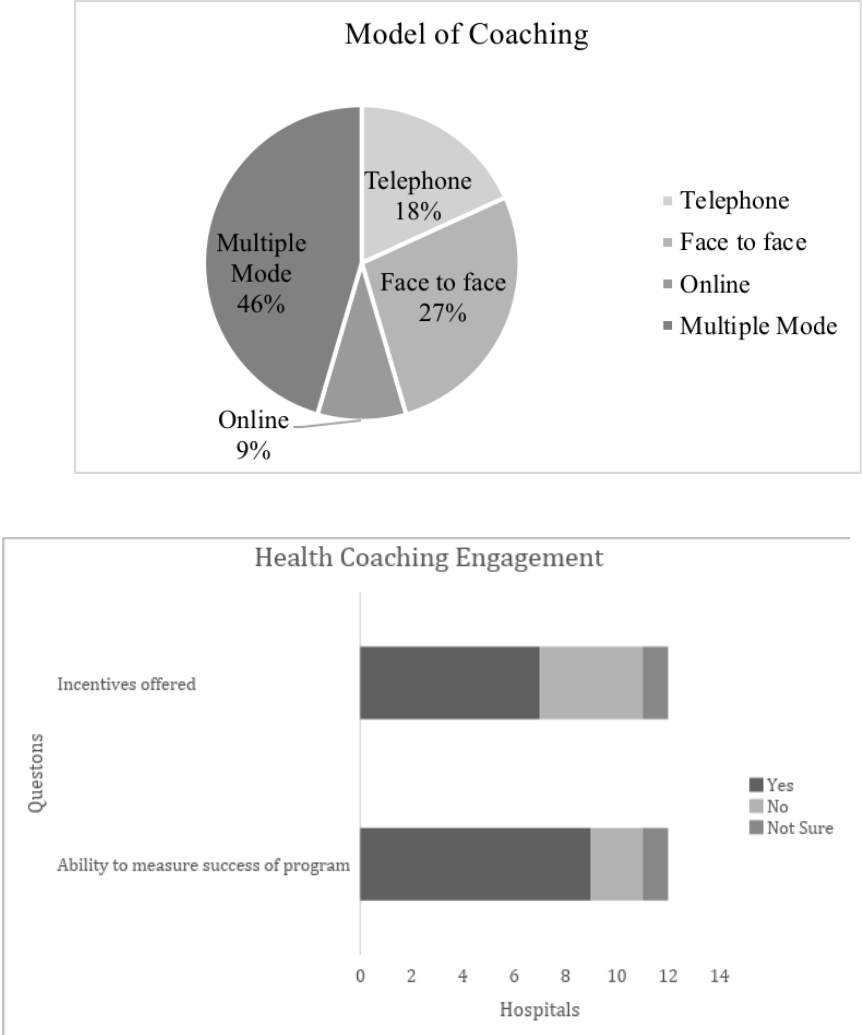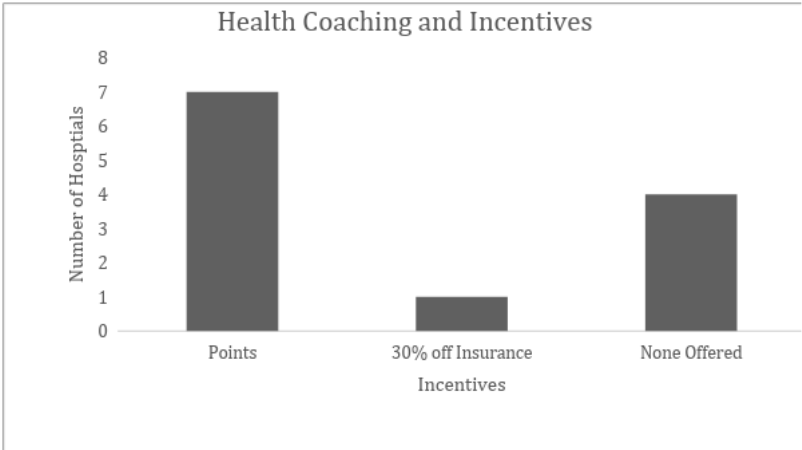
Merrimack College Merrimack College
Merrimack ScholarWorks Merrimack ScholarWorks
Health Sciences Student Work Health Sciences
Spring 2018
Best Practices for Implementing Health Coaching into an Best Practices for Implementing Health Coaching into an
Employee Health and Wellness Program Employee Health and Wellness Program
Caryn Bettencourt
Merrimack College
, bettencour[email protected]
Follow this and additional works at: https://scholarworks.merrimack.edu/hsc_studentpub
Part of the Community Health and Preventive Medicine Commons
Recommended Citation Recommended Citation
Bettencourt, Caryn, "Best Practices for Implementing Health Coaching into an Employee Health and
Wellness Program" (2018).
Health Sciences Student Work
. 12.
https://scholarworks.merrimack.edu/hsc_studentpub/12
This Capstone - Open Access is brought to you for free and open access by the Health Sciences at Merrimack
ScholarWorks. It has been accepted for inclusion in Health Sciences Student Work by an authorized administrator
of Merrimack ScholarWorks. For more information, please contact [email protected].
Running head: BEST PRACTICES FOR IMPLEMENTING HEALTH COACHING 1
Best Practices for Implementing Health Coaching into an Employee Health and Wellness
Program
Caryn Bettencourt
Merrimack College
BEST PRACTICES FOR IMPLEMENTING HEALTH COACHING 2
Abstract
Background: Many employers, from all different types of industries, offer wellness programs
for their employees. The goal of these “worksite” wellness programs is to give their employees
access to health programs to help them improve their health status. Through these worksite
health initiatives the employers have been able to realize an increase in productivity through
decrease in both absenteeism and presenteeism. The employers offer a diverse array of programs
to reduce health risks or support healthy choices. Health coaching is often included in these
worksite offerings. Health coaching is a partnership between the employee and the health coach
to work collaboratively to achieve their health goals. The purpose of this study is to determine
best practices for implementing health coaching into a worksite wellness program. Methods: A
thorough Internet search of award winning hospitals was conducted; ten hospitals throughout the
United States were selected. Each hospital participated in a telephonic interview and answered
eleven preselected standard questions developed from a comprehensive review of literature. A
qualitative analysis was used to evaluate the data. Results: The following four best practices
emerged from interviewing award-winning hospitals. 1. Allow an employee to choose what
health area to work on, 2. Sessions should be over the telephone or face to face, 3. The same
health coach should be used each session, and 4. The number of session should be twelve or
more. Discussion: The results provided evidence that correspond with previous literature.
Conclusion: Implementing the four best practices would conceivably increase employee
engagement in health coaching.
Key words: Worksite wellness, health coaching
BEST PRACTICES FOR IMPLEMENTING HEALTH COACHING 3
Introduction
Health
Health can be described in a number of different ways. In 1946 the World Health
Organization (WHO) defines health in a broader sense as “a state of complete physical, mental,
and social well-being and not merely the absence of disease or infirmity.” (WHO, n.d. Para.1).
Whereas, a Medical dictionary defines “ health as more than the absence of disease in realizing
that humans are dynamic beings and their state of health can change from day to day or hour to
hour thus looking at health on more of a continuum ranging from dire illness through the absence
of discernible disease to a state of optimal functioning in every aspect of one’s life. High level
wellness is described as a dynamic process in which the individual is actively engaged in moving
toward fulfillment of his or her potential.” In the United States, chronic diseases are the
fundamental source of poor health, disability, and death, and account for most of health-care
expenditures. (Bauer, 2014)
Wellness
Wellness is the process of being attentive to making observant decisions regarding one’s
health; and not just an individual’s physical health; but rather is a combination of physical,
mental, and spiritual well-being. This includes seven dimensions: social, emotional, spiritual,
environmental, occupational, intellectual, and physical. “ Wellness requires a disciplined practice
to become holistic through moving toward balance in all dimensions of wellness.” (Abbott,
2015).
Although, health is looked upon differently among the population, there is one unifying
thought: an individual’s responsibility to maintain one’s health. Although the individual is the
responsible party, the health industry is comprised of people wanting to help these individuals in
BEST PRACTICES FOR IMPLEMENTING HEALTH COACHING 4
their journey to maintain and/or improve their health. There is a multitude of different types of
professionals that have dedicate their lives to helping individuals stay or become healthy. The
healthcare and health related industry is a multi-billion dollar industry with a myriad of different
programs, processes, and professionals vying for business. This can make it difficult for someone
to know who to choose when looking for help. To support the following statement regarding
health choices, (Judith Hibbard, 2016) explains; “Efforts to support informed consumer choices,
have largely been a ‘one size fits all’ approach. Understanding consumers, and trying to meet
them where they are, is likely to be the focus of the ‘next generation’ of interventions to support
informed consumer choices. Research that informs how best to do customize information, for
different settings, will be needed to guide these efforts.” It is challenging for employers to
consider all research when cultivating a well-rounded presentation for their consumers.
Worksite Wellness
The definition of worksite wellness according to the Wellness Council of America is “An
organized program in the worksite that is intended to assist employee and their family members
in making voluntary behavior changes which reduce their health and injury risks, improve their
health consumer skills and enhance their individual productivity and wellbeing” (WELCOA,
2017).
According to Pescud et al., (2015) “Unhealthy lifestyles in the workplace has shown to
reduce productivity and increase absenteeism and presenteeism. The workplace covers a
considerable proportion of the adult population and is an optimal setting for health promotion
initiatives. Improving the health of a workforce is done by the following: health risk assessments,
vaccinations, wellness activities to improve healthy eating, physical activity, tobacco use,
alcohol consumption, and mental health outcomes.” Worksites offer ideal settings for reaching
BEST PRACTICES FOR IMPLEMENTING HEALTH COACHING 5
adults, including those at higher risk for chronic diseases” Polacsek et al., (2006). Another very
important point for an effective health and wellness program is the atmosphere or culture in
which individuals work. “A culture of health supports and encourages healthy lifestyles by
providing all employees with ongoing opportunities to maintain or improve their health status
across a variety of interventions” Grossmeier et al (2010). When the executives promote health
and wellness they provide a higher level of motivation for their employees to engage in the
program. Churchill et al., (2014).
One way to accomplish a successful health and wellness program according to (Putnam,
2017) is to:
1. Design and implement a health strengths assessment - Help people to
identify and celebrate what they are doing right.
2. Launch “start with what’s right” campaigns - Create excitement using
positivity to build a more resilient mindset.
3. Rename the program using uplifting themes such as “Winning Teams” -
this will generate good feelings that can motivate employees.
4. Make it fun - will help employees feel good which is a powerful
motivator.
5. Build a culture of health and learning - build an environment that helps to
support health and learning.
Applying this process will help to empower your employees and help them to believe in
themselves to make a change in their health.
BEST PRACTICES FOR IMPLEMENTING HEALTH COACHING 6
Health Coaching as Part of a Comprehensive Worksite Wellness Program
Employers are recognizing the value of offering worksite health and wellness programs.
These programs are aimed at developing a health conscious work environment. They take on
different forms but as a rule a comprehensive worksite program involves risk stratification, using
a self-reporting of health issues and concerns, a health risk assessment (HRA), behavior
modification programs, and health education for the employees. The organization benefits from
these programs by not only having a healthy workforce which decreases financial losses
associated with absenteeism and presenteeism. Their action shows the employees that the
organization values them and cares about their health and wellbeing. When the employer
commits to the development of a comprehensive worksite program they are showing that they
value and promote an environment of health in the organization. With the development of a
health and wellness committee the leadership provides a vehicle for the employee to make a
difference in the organization. This commitment serves to increase employee engagement in the
organization. The employee sees that the employer has aligned with them on health. This occurs
through these programs and incentives to encourage enrollment in the programs. The employee
then is more open to and can appreciate the mutual benefit of aligning with the employer on
other organizational goals. Therefore, these programs have a multifaceted value to the
organization and the employee. Health Research & Educational trust, (2016).
In looking at boosting employee empowerment, many worksite wellness programs
include the ability for employees to use the guidance of a health coach. Health coaches partner
with employees to move them forward toward living a healthier lifestyle. The National Society
of Health Coaching (NSHC) definition states that “health coaching is a framework of scientific
concepts that engage and guide individuals as they tap into their own inner motivation to better
BEST PRACTICES FOR IMPLEMENTING HEALTH COACHING 7
manage their own health conditions” (Huffman, 2011). Thus, this field came out of motivational
interviewing from the 1990’s and has continued to grow into a certified employable position.
Health coaches are used in many different settings including, but not limited, to communities,
primary care, worksites, and individual populations Butterworth et al., (2007). “Primary
objectives of health coaching are to educate the patient regarding self-management and to
encourage patients in taking a more proactive role in staying healthy” (Buckley, 2010). Health
coaching provides an approach that can meet the unique needs of an individual. This type of
program can therefore meet the specific needs of employees.
Impact of Coaching
A health coach can work with individuals on a variety of different health related lifestyle
issues including: self-managing chronic conditions, starting an exercise program, smoking
cessation, increasing energy, managing stress, sleeping better, incorporating a better diet and
nutrition, and pain management. In working with a health coach, individuals have shown
improvements in their health behaviors, self-efficacy, and goal setting skills. Participants
implemented positive lifestyle changes and learned skills to maintain these positive changes
Clark et al., (2016). In a study that followed patients for twenty-four months looking for the
lasting effects of health coaching, documenting results at twelve months and twenty-four months,
they found that their results at the end of the study had been maintained which predicted lasting
effects from health coaching. Sharma et al., (2016). In look looking for the lasting at the
effectiveness of a health coaching intervention, there are four things to look at: health related
behaviors, health status, productivity, and healthcare utilization Butterworth et al., (2007). The
value for the employer is also obvious, as described by (Ashworth, 2017) in five top reasons why
a company would want to hire a health coach:
BEST PRACTICES FOR IMPLEMENTING HEALTH COACHING 8
1. Health coaches can work with individuals to improve overall company health.
2. The personal one-on-one interaction can allow employees to feel engaged in the wellness
program.
3. The health and wellness coaches can serve as independent spokespeople.
4. The employees can demonstrate the benefits they receive from coaching.
5. Health coaches can collect feedback from employees.
In a study conducted at Mercy Clinics on the value of health coaching results showed that
“overall the health coach activities improve compliance and documentation for chronic patients,
enable higher level billing, and increase clinician productivity.” Lanese et al., (2011).
Engagement
Employee engagement refers to the emotional connection that an individual feel
toward his or her employment organization. Communication between management and
employees is the basis for creating employee engagement. There are many benefits that occur
when engagement is high, companies will see lower turnover, higher productivity, a better
atmosphere will develop, and the company will see greater profitability. Motivating employees
can come with its challenges, for example, employers sometimes focus on the bottom line and
not their employees or the leaders are not inspiring to their employees. In building employee
engagement there are several ways this can be done. First, trust must be developed among
management and employees, then, management must establish clear expectations, and finally,
management needs to show appreciation.
One must consider the following when choosing a health coach:
BEST PRACTICES FOR IMPLEMENTING HEALTH COACHING 9
they need to have trust and the right contact information must be provided, they must be able to
leverage the teachable moment, be timely and effective in responding to employees, use
personalized messaging, and when necessary, relevant incentives can be utilized.
Incentives
An incentive can be defined as a thing that motivates or encourages an individual to do
something. In a worksite wellness program different forms of incentives are used to increase
program participation and encourage positive employee health behavior. There are different
strategies for incentives, which are either participation-based, outcome-based, or progress-based.
Wellness Connector, (2017) An example of an incentive would be receiving fifty dollars for
completing a biometric screening.
Financial incentives are used in a worksite wellness program to motivate participation. Does this
work for health coaching? One study found that offering financial incentives for health coaching did
show a higher completion rate, but improved health does not necessarily follow (Gingerich, 2012).
Another study suggests that financial incentives need to be clarified to see if they are effective in
driving deeper engagement in coaching programs, besides just the enrollment (Grossmeier, 2013).
Yet another study states that financial incentives are effective for short-term behavior such as
completing an HRA rather than a more complex outcome such as weight loss Churchill et al., (2014).
Choice Architecture
In thinking of engagement, one theory looks at an individual’s ability to choose or make
decisions. “Choice architecture can be used to help nudge people to a make better choice (as
judged by themselves) without forcing certain outcomes upon anyone.” Thaler et al., (2008). In
one study “authors examined the use of coaching for participants with diabetes, asthma or
cardiovascular disease. Given the choice, 80 percent of these consumers with chronic conditions

BEST PRACTICES FOR IMPLEMENTING HEALTH COACHING 10
selected a lifestyle topic as their coaching focus. The net impact of providing choice was delivery
of three times as much condition-relevant coaching than they would have received in a
traditional disease management model.” Barleen et al., (2015). A traditional disease
management model focuses solely on the health risk of an employee and not providing them with
the opportunity to make choices.
Coaching Design
Health Coaching Models
There are several different coaching models, similar in structure, which follow these
steps.
1.Pre-coaching phase includes reviewing an assessment and building relationships.
2. Active Coaching phase where the purpose and goals are clarified, and a plan is
developed with a commitment to act.
3. Follow-up phase the plan or new behaviors are enacted and coaching feedback is
provided. Dyess et al., (2017).
In coaching building a trusting relationship is the foundation that provides the basis for success.
Thom et al., (2016).
Delivery of Coaching
The process of health coaching can be delivered in a couple of different models including
the transtheoretical model and collaborative care model. . The Transtheoretical Model of
Behavior Change assesses an individual's readiness to act on a new healthier behavior, and
provides strategies, or processes of change to guide the individual through the stages of change
to Action and Maintenance. (“Transtheoretical Model,” n.d.). One of the strengths of this model
is that it is a comprehensive theory of change that can be applied to a variety of behaviors. A

BEST PRACTICES FOR IMPLEMENTING HEALTH COACHING 11
limitation of this model is that this theory ignores the social context in which change occurs,
such as income. The next model the collaborative care model is one that is team driven,
population focused, measurement-guided, and evidence based. A strength of this model is that it
is a multidisciplinary group of healthcare delivery professionals providing care in a coordinated
fashion and empowered to work at the top of their professional training. A limitation of this
model is management turnover can impede the process of the collaboration of healthcare teams.
American Psychiatric Association, (2017).
The components of a successful coaching model blend the following self-efficacy and
risk participation, values, experiences, barriers, and resources. (Reed, 2009).
Traits of Coaching
A health coach should possess the following qualities first he or she must be empathetic,
a good listener, be trustworthy, non-judgmental, honest, and can motivate another individual.
Health coaches do not diagnose, interpret behavior or beliefs, or clinically advise patients on
what to do Wolever et al., (2016).
Empathy is especially important when working as a health coach this quality is the one
that can allow you to be present in the moment and truly listen to your client.
The process of health coaching can be conducted in several different forms; face to face,
telephonically, e-mail, or internet (Skype would be an example). “Generally, the in-person or
telephonic formats are favored because they are more compatible with the interactive, non-
scripted motivational interviewing-based approach” Butterworth et al., (2007). Another article
quoted, “When I would get a call it would be a different coach each time who didn’t know me.
That was very frustrating.” Hill-Mey et al., (2013). A coaching program should provide the
participant with access to the same coach for the duration of their participation. A relationship

BEST PRACTICES FOR IMPLEMENTING HEALTH COACHING 12
should be built with the coach and participant. Unfortunately, this cannot be done if each
coaching session you have a different coach.
Training
The journey to become a health coach begins with enrolling in a training program that
can last up to several years. The growth process of becoming a health coach is continually
evolving. “A joint volunteer effort is underway to develop a national standard for training and
certification of health and wellness coaches in the United States.” Smith et al., (2013).
When an employer is looking to add health coaching to their health and wellness
program, they need to select coaches who are certified. One must have one of the following in
order to sit for the certification exam: Clinical license, bachelor’s degree or higher in a health
related domain, bachelor’s degree or higher in a non-health related domain plus 2000 hours work
experience in health, allied health, and wellness, those who have accredited fitness certification,
ministers, hospice workers, pastoral counselors, teachers, healthy food chef, whole foods
advocates, and coaches credentialed by the International Coaching Federation. Training
programs should assess practical skills, performance, and require the demonstration of safe, basic
competency before individuals may graduate from their program. Jordan et al., (2015).
Health coaches are required to submit thirty-eight hours of continuing education credits
within a three year period. This can be completed by taking online webinars, readings, quizzes,
and seminars.
Barriers to Participation
The following are some barriers that employees cited as reasons for not participating
● Time restrictions
● Feeling the program was a low priority

BEST PRACTICES FOR IMPLEMENTING HEALTH COACHING 13
● Distance problems
● Professional and personal responsibilities getting in the way
● Confidentiality concerns or worries about strange people calling
and asking questions about that individual’s health.
● Keeping one’s own health records
● Already knowing they are healthy
● The incentives not being enough
● Feeling the program was irrelevant because they were on their
spouse’s insurance program. Hill-Mey et al., ( 2013) .
Summary
Health coaching within a worksite wellness program can add another option for
guiding their employees toward living a healthier lifestyle. Employers are showing their
employees the level of commitment they have in facilitating behavior change. Worksite wellness
programs have the ability to allow coaches to work with their employees in an effort to create
productive and effective staff members.
What Is Benchmarking
Primarily to identify the best practices adopted in world-class companies which leverage
them to high-level performance and leading position, and implement such practices in one's own
company. This is a continuous learning process that will bring about a pragmatic search of new
ideas. This process takes time and the work requires discipline. Once completed this is a
powerful tool that delivers useful information for a sustainable improvement of the maintenance
organization. Business dictionary, (2017).

BEST PRACTICES FOR IMPLEMENTING HEALTH COACHING 14
Benchmarking provides a information that can identify where a company is doing well
and where they need to make changes. The process of benchmarking is a more efficient way to
make improvements.
This project will contact ten to fifteen hospitals in an effort to hear what is working or not
in reference to health coaching.
Methodology
Participants:
Ten to fifteen hospitals that offer health coaching as an option in their health and
wellness program. The hospitals have been contacted from all over the United States and were
willing to participate in a phone interview.
The inclusion criteria is:
1. The facility must be a hospital.
2. They must have a health and wellness program.
3. They must offer health coaching as part of the health and wellness program.
The exclusion criteria is:
1. The facility is not a hospital.
2. The hospital does not offer a health and wellness program.
3. The hospital does not offer health coaching.
4. An employee from the hospital’s Human Resources or employee wellness department has
been contacted and he or she must be familiar with their health coaching program.
Procedure:
A thorough internet search was completed and twenty-five hospitals from around the
United States were identified and each one has a health and wellness program. Healthcare
BEST PRACTICES FOR IMPLEMENTING HEALTH COACHING 15
Business & Technology, (2012). The next step was calling these hospitals and creating a list of
the hospitals that has health coaching as an option.
The list of hospitals that have a health coaching option was documented and from this list ten to
fifteen hospitals was chosen based off of the willingness to participate in a phone interview. The
finalized list of hospitals that agreed to participate was recruited by January 2018. There will not
be an incentive provided for participating in this study.
A phone call was placed to ten to fifteen hospitals that have agreed to participate in a
thirty minute interview. Prior to the interview verbal consent was given by each hospital
participant.
Measures:
An interview was developed for this study to document information from hospitals about
their health coaching and wellness program. These questions include:
1. Does their wellness program include participation in a health assessment and/or biometric
screening?
2. Do you have a health coaching program?
3. Is the coaching program integrated with the health assessment and/or screenings? (same
vendor, data shared).
4. If so, what is the model telephone, face to face, or virtual?
5. Who is eligible to participate in this program? (All employees, only high risk employees)
6. Are participants allowed to select what health risk/area they would like to work on?
7. How many calls are they allowed?
8. Are they assigned a dedicated coach or does the coach vary session to session?
9. Do they provide incentives for participation in health coaching?
BEST PRACTICES FOR IMPLEMENTING HEALTH COACHING 16
10. What percentage of employees participate?
11. Do you have the ability to measure the success of health coaching? If so, what is the
measurement?
Data Analysis:
The qualitative interview data was analyzed to identify themes related to the role of
health coaching in a health and wellness program. The information was read and assigned coding
categories. The information was analyzed that the following information was found.
Results:
In order to determine the best practices for health coaching within a hospital employee
health and wellness program other hospitals were interviewed on the details of their program.
The hospitals were determined using the following protocol.
Each year the Wellness Counsel of America (WELCOA) produces a list of their employee
health and wellness award winning hospitals. The participants for this interview were chosen
from this list. There were twelve hospitals contacted all agreed to participate in the interview.
Two interviews were with the health and wellness director, three were with the health and
wellness coordinator, and seven hospitals I interviewed the health and wellness manager. These
hospitals were located throughout the United States including California, Ohio, Oregon,
Wisconsin, Massachusetts, New Jersey, Missouri, Colorado, and Florida. The demographics of
the hospitals interviewed include; five hospitals with less than 2,500 employees, five that has
between 2,500 and 5,000, and two with more than 5,000. The number of beds in each hospital
ranged from 25 – 1440.

BEST PRACTICES FOR IMPLEMENTING HEALTH COACHING 17
Demographics:
Table 1 Demographic Information for Participants
Hospital
Number of Beds
Number of Employees
1
78
814
2
253
4600
3
259
3080
4
493
3850
5
1440
40000
6
293
7400
7
353
2053
8
100
1108
9
67
1076
10
139
980
11
25
450
12
284
2600
Table 1 above shows the number of beds and employees for each hospital that was interviewed
Health Coaching
Figures 1-3 represents a sampling of questions from the interview of hospitals throughout the
United States.
Figure 1 provides information on participation and health coaching in United States Hospitals

BEST PRACTICES FOR IMPLEMENTING HEALTH COACHING 18
In evaluating the data, it was revealed that all twelve hospitals participated in a health
assessment and biometric screenings. Health coaching was offered in all of the hospitals but only
eight hospitals integrated with the health assessment and screenings.
Figure 2 represents the design of health coaching
This study provided information on the design of coaching 90% of hospitals responding
stated they offered health coaching to all employees’ not just employees with a high-risk illness.
When asked if employees were allowed to focus on the health area of their choice 80% of the
respondents stated yes. Sixty-four percent (64%) of the hospitals allowed an unlimited number
of calls or sessions with the coach. Eight-two percent (82%) of the participants had the
opportunity to meet with the same coach each session.
Another important area that was looked at is the modality of health coaching.
The model of health coaching offered within the employee health and wellness programs are
telephonic, face-to-face or online. Telephonic includes coaching over the telephone, face to face

BEST PRACTICES FOR IMPLEMENTING HEALTH COACHING 19
is when coaching is conducted in person, and online uses a program where you can see each
other over the computer. The percentages for each type of coaching if represented below.
Figure 3 highlights the different models of coaching from eleven of the twelve hospitals.
Figure 4 represents health coaching engagement

BEST PRACTICES FOR IMPLEMENTING HEALTH COACHING 20
Figure 4 represents whether the hospital offers incentives for employees who participate in
the health coaching program and Figure 5 goes into more detail about what types of incentives
were offered across respondents. The following metrics are used health screening and
biometrics, claims data, the health coach’s data or health plan data to assess if the hospital’s
health coaching program is successful
Figure 5 Incentives offered for health coaching
Incentives within an employee health and wellness program include earning points that can be
utilized for prizes, cash, or a discount toward health insurance.
There were eight hospitals that provided points that could be used toward cost savings, four
hospitals did not offer any incentives, and one hospital took thirty percent (30%) off of the
employee’s insurance premium.
Finally, when asked about the percent of employee’s who participant in health coaching the
response from many of the hospitals was that it is low or unknown. The few hospitals that did
track this data expressed that there was 2-3% participation in their health coaching program. The
BEST PRACTICES FOR IMPLEMENTING HEALTH COACHING 21
highest involvement for health coaching within an employee health and wellness program was
10%. I did have two hospitals state that this was an area they wanted to start tracking this data.
Discussion
The current study was to 1.) Assess current practices of health coaching in award winning
hospital employee health and wellness programs. 2.) A telephonic interview was used to acquire
the information using specific questions on how the hospitals incorporate health coaching into
their program. 3.) The hospitals that participated were selected using the criteria that they were
located in the United States and must offer health coaching to their employees. The major
finding to foster employee engagement in health coaching are as follows: That choice is an
important factor, the mode of coaching does make a difference, using the same coach each
session has a significant impact on an individual’s progress, and the number of sessions allowed
with the coach should not be limited. Employee Benefit News, (2017) states that “by offering
health and wellness coaching services, it shows that the company is invested in the health of it
employees.” underscores the importance of implementing health coaching into an employee
health and wellness program.
The results from the benchmarking process with hospitals across the United States has
provided information to develop four best practices for implementing health coaching into an
employee health and wellness program, that are well supported by previous literature.
Allowing an employee to make a choice and recognizing humans as individuals and
providing dignity will allow an individual to achieve their full potential. As human beings we
have a superior capacity for making decisions, they can be emotional or rational. Choice is
extremely important when developing an employee health and wellness program. As stated
“Choice is a key engagement element for consumers with a health condition.” Barleen et.al.,
BEST PRACTICES FOR IMPLEMENTING HEALTH COACHING 22
(2015) Individuals feel better off when they are allowed to make a choice, and research supports
equal or greater outcomes when choices is allowed.
When working with a coach their needs to be trust and a relationship built. According to
Thom et al., (2016) in coaching building a trusting relationship is the foundation that provides
the basis for success. Building this relationship takes time and effort. The coach also needs to
show empathy and hold the individual accountable for their goals. The employee needs to
become comfortable with his or her coach. This is why the employee should meet with the same
coach each session. Seeing the same coach will allow the employee to build trust and rapport. If
the employee is not allowed to meet with the same coach, then his or her progress will not
continue to move forward. Eighty-two percent of the hospitals interviewed had provided that
their coaching participants meet with the same coach throughout the program.
Coaching takes time, availability, and accessibility. The mode in which someone
participates in health coaching is also very important. This study found that health coaching
should be offered either face to face or telephonically. It was found that individuals do their best
work with a coach when they can sit across from them and have a conversation. If they are
coached over the phone the process does work just as well and can be easier to schedule, and less
expensive to implement.
The number of sessions the coach and employee meet should not be pre-determined
because each individual is unique. The number of sessions varies for each person it is not a one
size fits all type of process. Therefore, in a health and wellness program the number of health
coaching sessions should be as many as the employee needs to make progress. They should work
with the coach enough to assist them in managing their health until they can do it on their own.
BEST PRACTICES FOR IMPLEMENTING HEALTH COACHING 23
The United States Preventative Task Force states that intensive intervention to drive behavior
change is twelve or more sessions. (United States Preventative Task Force, 2017).
Employers offer incentives that help to motivate employees to participate in the health
and wellness program. Incentives work to bring someone into the program, but they are not able
to change the behavior of an employee. Behavior change requires effort and time to build the
new way of doing something. There are a number of theories that a coach can use when working
with someone to change their behavior. (Gingrich, 2012) stated that financial incentives for
health coaching did show higher completion rate but improved health did not follow.
Application and Implications
According to the current study, the information provided did correlate with prior
literature. The data from interviewing hospitals throughout the United States provided enough
information to determine four best practices for implementing health coaching. These best
practices are allowing choice, offering coaching telephonically or face to face, having the same
coach each session, and providing twelve or more sessions. Implementing these practices should
produce a greater increase of engagement in health coaching.
Limitations
A limitation of the present study is the insufficient data on the percentage of participation
in health coaching among hospital employee health and wellness programs that were
interviewed. Another limitation is the data on the overall effectiveness of coaching was too
varied to develop a comprehensive picture on the impact of coaching from this benchmarking.
One final limit is that this study was limited to hospitals. The results of this study could
potentially be implemented into other settings such as corporations.
BEST PRACTICES FOR IMPLEMENTING HEALTH COACHING 24
Future Directions
It would be interesting to further explore the role of health coaching in an employee
health and wellness program other than hospitals. In looking at other worksite wellness settings a
study could be conducted to compare the different settings and look for the differences and
similarities between them. Also, in looking at the mode of coaching with the further development
of technology, virtual physicians, and apps for phones this advancement could help to add
another option for health coaching.
Conclusions
In summary the most important finding in this study is that there are specific practices
that will allow health coaching to be used as a valuable resource for behavior change within an
employee health and wellness program. Implementing and following the best practices can
potentially increase participation. Hospital employers can use this information to implement
health coaching into their employee health and wellness program. Thus, their employees can use
health coaching to make the changes they need to lead a healthy lifestyle and perform their duties
at work to their fullest potential.

BEST PRACTICES FOR IMPLEMENTING HEALTH COACHING 25
References
Abbott, R. A., & Baun, W. B. (2015). The multi-dimensions of wellness: The vital role of terms
and meanings. American Journal Of Health Promotion, 29(5), 8-10.APA-APM-
Dissemination-Integrated-Care-Report%20(2).pdf
www.psychiatry.org/psychiatrists/practice/professional-interests/integrated-care/get-
trained/about-collaborative-care
American Journal of Health Promotion July 2017, Vol. 31 Issue 4, p361 4p.
Ashworth, D. (2017). Can health coaching increase employee engagement? Employee Benefit
News (Online), Retrieved from http://proxy3.noblenet.org/login?url=https://search-
proquest-com.proxy3.noblenet.org/docview/1918885318?accountid=40663
Barleen, N., Ph.D., Higgins, A., Dr.P.H., Dobro, J., M.D., & Zimmerman, E., M.P.H., M.B.A.
(2015). Impact of Choice-Based Design on Population Health. RedBrick Health,1-28.
Retrieved October 10, 2017, from http://home.redbrickhealth.com/results/white-papers
Bauer, U. E., Briss, P. A., Goodman, R. A., & Bowman, B. A. (2014). Prevention of chronic
disease in the 21st century: elimination of the leading preventable causes of premature
death and disability in the USA. Lancet (London, England), 384(9937), 45-52.
doi:10.1016/S0140-6736(14)60648-6
Bauer, Ursula E et al.
benchmarking. BusinessDictionary.com. Retrieved November 20, 2017, from
BusinessDictionary.com website:
http://www.businessdictionary.com/definition/benchmarking.html
Buckley, Patrick T,M.P.A., I.H.C. (2010). Health coaching good for your patients and
your practice. Medical Economics, 87(22), 60-70. Retrieved from

BEST PRACTICES FOR IMPLEMENTING HEALTH COACHING 26
http://proxy3.noblenet.org/login?url=https://search-proquest-
com.proxy3.noblenet.org/docview/818553352?accountid=40663
Butterworth, S., Moore, M., Stolzfus, J., & Walkup, R. B. (2014). Coaching Experts Discuss the
Relationships Between Coaching, Culture, and Health Outcomes and for What Coaches
Should Be Held Accountable. American Journal Of Health Promotion, 28(6), TAHP-3-
TAHP-7.Hibbard, J. H. (2017). Patient activation and the use of information to support
informed health decisions. Patient Education And Counseling, (1), 5.
doi:10.1016/j.pec.2016.07.006
Can health coaching increase employee engagement? (2017, July 14). Business Insights:
Essentials.
Clark, M. M., Bradley, K. L., Jenkins, S. M., Mettler, E. A., Larson, B. G., Preston, H. R., . . .
Douglas, K. S. (2015). Improvements in Health Behaviors, Eating Self-Efficacy, and
Goal-Setting Skills Following Participation in Wellness Coaching. American Journal of
Health Promotion,30(6), 458-464. doi:10.4278/ajhp.140627-qual-304
Churchill, S. A., Gillespie, H., & Herbold, N. H., EdD. (2014). The desirability of wellness
program and incentive offerings for employees. Benefits Quarterly, 30(1), 48-57.
Retrieved from http://proxy3.noblenet.org/login?url=https://search-proquest-
com.proxy3.noblenet.org/docview/1512705068?accountid=40663
Crabb, S. (2011). The use of coaching principles to foster employee engagement. Coaching
Psychologist, 7(1), 27-34.
Dyess, S. M., Sherman, R., Opalinski, A., & Eggenberger, T. (2017). Structured coaching
programs to develop staff. The Journal of Continuing Education in Nursing, 48(8), 373-
378. doi:http://dx.doi.org.proxy3.noblenet.org/10.3928/00220124-20170712-10

BEST PRACTICES FOR IMPLEMENTING HEALTH COACHING 27
Gingerich, S. B., Anderson, D. R., & Koland, H. (2012). Impact of Financial Incentives on
Behavior Change Program Participation and Risk Reduction in Worksite Health
Promotion. American Journal of Health Promotion,27(2), 119-122.
doi:10.4278/ajhp.110726-arb-295
Grossmeier, J., Terry, P. E., Cipriotti, A., & Burtaine, J. E. (2010). Best Practices in Evaluating
Worksite Health Promotion Programs. American Journal of Health Promotion,24(3).
doi:10.4278/ajhp.24.3.tahp
Grossmeier, J. (2013). The Influence of Worksite and Employee Variables on Employee
Engagement in Telephonic Health Coaching Programs: A Retrospective Multivariate
Analysis. American Journal Of Health Promotion, 27(3), e69.
https://medical-dictionary.thefreedictionary.com/health
Health Research & Educational Trust. (2016, October). Health and wellness programs for
hospital employees: Results from 2015 American Hospital Association survey. Chicago,
IL: Health Research & Educational Trust. Accessed at www.hpoe.org
Hibbard, J. H. (2017). Patient activation and the use of information to support informed health
decisions. Patient Education and Counseling,100(1), 5-7.
doi:10.1016/j.pec.2016.07.006
http://hin.com/blog/2009/10/1/3-health-coaching-models-for-behavior-change
Hill-Mey, P. E., Merrill, R. M., Kumpfer, K. L., Reel, J., & Hyatt-Neville, B. (2013). A Focus
Group Assessment to Determine Motivations, Barriers and Effectiveness of a University-
Based Worksite Wellness Program.
Home - US Preventive Services Task Force. (n.d.). Retrieved from
https://www.uspreventiveservicestaskforce.org/

BEST PRACTICES FOR IMPLEMENTING HEALTH COACHING 28
Huffman, Melinda H., BSN, MSN,C.C.N.S., C.H.C. (2010). Health coaching. AAOHN Journal,
58(6), 245-50; quiz 251-2. doi:http://dx.doi.org.proxy3.noblenet.org/10.3928/08910162-
20100526-02
Jordan, M., Wolever, R. Q., Lawson, K., & Moore, M. (2015). National training and education
standards for health and wellness coaching: the path to national certification. Global
Advances In Health And Medicine, 4(3), 46-56. doi:10.7453/gahmj.2015.039
Lanese, B. S., Dey, A., Srivastava, P., & Figler, R. (2011). Introducing the health coach at a
primary care practice: impact on quality and cost (Part 1). Hospital Topics, 89(1), 16-22.
doi:10.1080/00185868.2011.550207
Matthews, M. (2009). 3 Health Coaching Models for Behavior
Change.http://hin.com/blog/2009/10/01/3-health-coaching-models-for-behavior-change/
[Accessed 16 Nov. 2017].
Patricia E., H., Ray M., M., Karol L., K., Justine, R., & Beverly, H. (2013). A Focus Group
Assessment to Determine Motivations, Barriers and Effectiveness of a University-Based
Worksite Wellness Program. Health Promotion Perspectives, Vol 3, Iss 2, Pp 154-164
(2013), (2), 154. doi:10.5681/hpp.2013.019
Pescud, M., Teal, R., Shilton, T., Slevin, T., Ledger, M., Waterworth, P., & Rosenberg, M.
(2015). Employers' views on the promotion of workplace health and wellbeing: a
qualitative study. BMC Public Health, 15(1), 1-10. doi:10.1186/s12889-015-2029-2
Prevention of chronic disease in the 21st century: elimination of the leading preventable
causes of premature death and disability in the USA
Polacsek, M., PhD, MHS, O'Brien, L. M., PhD, Lagasse, W., MSB, CHES, & Hammar, N.
(2006). Move & Improve: A Worksite Wellness Program in Maine. Preventing Chronic
Disease Public Health Research, Practice, and Policy,3(3), 1-8.

BEST PRACTICES FOR IMPLEMENTING HEALTH COACHING 29
Putnam,, L., MA. (2017). Positive Thoughts, Positive Results: Jumpstart Your Worksite
Wellness Initiative by Starting With What's Right. American Journal of Health
Promotion,31(4), 361-364.
Reh, F. J. (2017). Benchmarking Overview, Practices and Approaches in Business. Management
& Leadership. Retrieved from http://www.thebalancecareers.com/overview-and-
examples-of-benchmarking-in-business
Richard H., T., Cass R., S., & John P., B. (2010). CHOICE ARCHITECTURE 0.Gingerich, S.
B., Anderson, D. R., & Koland, H. (2012). Impact of financial incentives on behavior
change program participation and risk reduction in worksite health promotion. American
Journal Of Health Promotion, 27(2), 119-122. doi:10.4278/ajhp.110726-ARB-295
Sharma, A. E., Willard-Grace, R., Hessler, D., Bodenheimer, T., & Thom, D. H. (2016). What
Happens After Health Coaching? Observational Study 1 Year Following a Randomized
Controlled Trial. Annals Of Family Medicine, 14(3), 200-207. doi:10.1370/afm.1924
Smith, L. L., Lake, N. H., Simmons, L. A., Perlman, A., Wroth, S., & Wolever, R. Q. (2013).
Integrative Health Coach Training: A Model for Shifting the Paradigm toward Patient-
centricity and Meeting New National Prevention Goals. Global Advances in Health and
Medicine,2(3), 66-74. doi:10.7453/gahmj.2013.034
Susan W., B., Ariel, L., & Wende, M. (2007). Health Coaching as an Intervention in Health
Management Programs. Disease Management And Health Outcomes, (5), 299.
T.M. (n.d.). In Wikipedia. Retrieved December 7, 2017, from
http://en.wikipedia.org/wiki/transtheoretical model.
Thaler, R. H., & Sunstein, C. (n.d.). Choice Architecture. PsycEXTRA Dataset.
doi:10.1037/e722852011-067

BEST PRACTICES FOR IMPLEMENTING HEALTH COACHING 30
The Lancet , Volume 384 , Issue 9937 , 45 - 52
Thom, D. H., Wolf, J., Gardner, H., DeVore, D., Lin, M., Ma, A., & ... Saba, G. (2016). A
Qualitative Study of How Health Coaches Support Patients in Making Health-Related
Decisions and Behavioral Changes. Annals Of Family Medicine, 14(6), 509-516.
doi:10.1370/afm.1988
What is benchmarking? (2014, December). Fleet Maintenance. Retrieved from
http://go.galegroup.com.proxy3.noblenet.org/ps/i.do?p=ITOF&sw=w&u=9211haea&v=2
.1&it=r&id=GALE%7CA407184799&sid=ebsco&asid=6fbe3f525498bf290b2d9cde3eab
cd5e
Where Are America's Best Hospitals? (n.d.). Retrieved from http://health.usnews.com/best-
hospitals
Wolever, R. Q., Jordan, M., Lawson, K., & Moore, M. (2016). Advancing a new evidence-based
professional in health care: job task analysis for health and wellness coaches. BMC
Health Services Research, (1), doi:10.1186/s12913-016-1465-8
http://www.wellnessconnector.com/overview
World Health Organization. (n.d.). Frequently asked questions. Retrieved from
http://www.who.int/suggestions/faq/en/
